Overview
As of March 31st, 2022, the total route length of the Indian Railways is over 67,856 km, and the track length is 126,366 km. This makes it the fourth-largest National Railway System in the world. It also holds a Guinness World Record for being the world’s largest railway network under a single management.
The Indian railway lines were originally constructed by the British for facilitating colonial interests until they were nationalised in 1951. Over the years several railway lines were dismantled and replaced while new ones were also added. Many bridges have also been erected to connect lines crossing over rivers and other obstacles.
Let’s have a look at some of these fine works of masonry.
Pamban Bridge, Tamil Nadu
Designed by German engineer William Scherzer and erected in 1914, Pamban Bridge is the first sea bridge in India. The mega-structure was designed to allow sea traffic to pass by means of a rolling lift that opened two leaves of the bridge upwards.

(Image Credit: Business Insider India)
The bridge initially ferried meter-gauge trains plying between Mandapam on the mainland and Pamban on Rameshwaram Island. It was closed in 2018 for maintenance work during which its rolling type span was replaced with a single truss span.
This allowed it to carry the load of broad gauge trains where previously it could only bear the load of meter gauge tans. Following the upgrade, the bridge was re-opened in 2019.
Vembanad Bridge, Kerala
Connecting Vaddarpallam and Eddapalli in Kochi, Kerala, Vembanad Bridge is the second longest railway bridge in India. The bridge is used exclusively by trains carrying cargo, with an average of around 15 trains crossing it daily.
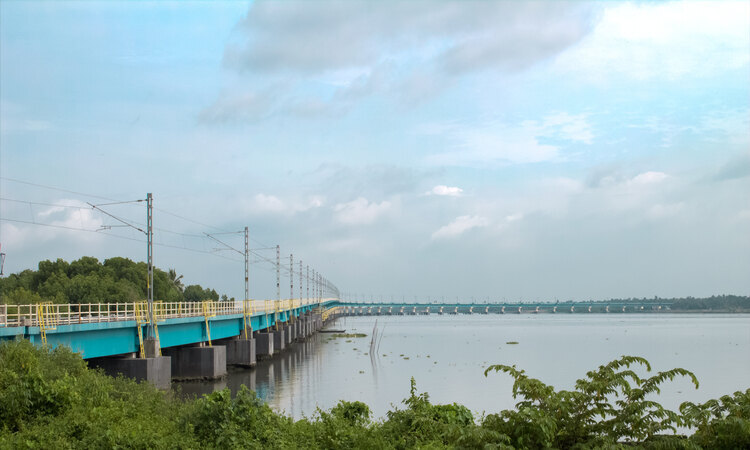
(Image Credit: Wikipedia)
It extends over the backwaters and three islands of Vembanad lake, which like the bridge is the longest lake in the country. The lake is also the largest in the state of Kerala.
This bridge is held up by pile foundations that have been laid at 133 different locations. It was constructed using 58,000 tonnes of cement, 117,000 tonnes of reinforced steel, 99,000 cubic meters of metal aggregates, 127,000 cubic meters of concrete work, 735,000 cubic meters of sand, and 154,308 cubic meters of earthwork.
Konkan Railway Bridge, Maharashtra
The Konkan Railway bridge, also known as the Zuari Bridge is located in Goa stretching over the Zuari River. The bridge is 1,321 meters long and is the longest railway line in the Konkan rail network. The Konkan Rail Network is considered to be among the most aesthetically appealing train routes that connect Karnataka, Goa, and Maharashtra States.
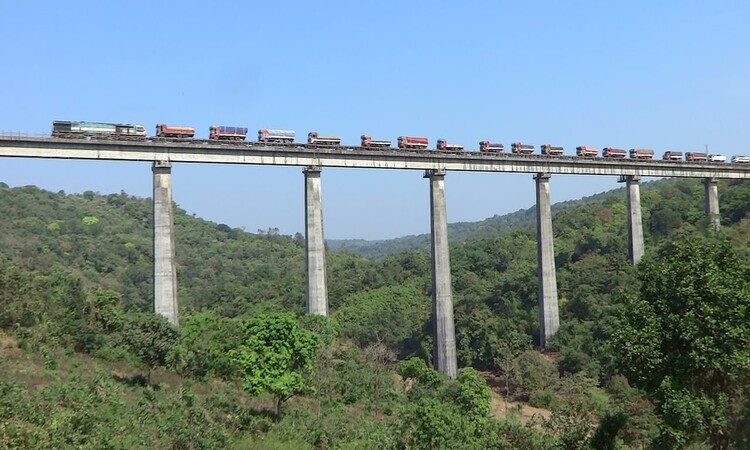
(Image Credit: YouTube)
At a height of 60 meters, the Konkan Bridge is the tallest railway bridge in India and is among the tallest in Asia. The viaduct has been erected upon tampering and hollow, octagonal pylons have been constructed employing the strong slip-form technique of Continous Construction. The bridge is the first one in India to have been constructed using this technique,
Jubilee Bridge, West Bengal
Jubilee Bridge is a notable bridge in West Bengal that runs over the Hooghly River connecting Bandel and Naihati in Kolkata. It was inaugurated on 16 February 1885. This was the year that Queen Vicotria marked the golden jubilee of her reign over the British Empire which is how the bridge got its name.

(Image Credit: Wikipedia)
The bridge was designed by the erstwhile Chief Engineer of India Sir Bradford Leslie along with Alexander Meadows Rendel. Lt Colonel Arthur John Barry was the Chief Engineer in charge of construction. It is a cantilever truss bridge that is constructed exclusively by riveting. No nuts or bolts were used in its construction.
Jubilee Bridge was used by the Indian Railways for 129 years before being decommissioned on 17 April 2016. The Teesta Torsha Express was the last train that passed through it.
Sharavati River Bridge, Karnataka
The Sharavti Bridge which was completed in 1984 is located south of Honnavar in the State of Karnataka. It is used by the Konkan Railway to cross the Sharavti River. Measuring 2,060 meters long, it is the longest bridge on that railway and also the longest in the state.
The overall length of the bridge is 1047.65 meters and it is comprised of 34 spans each measuring 30 meters. Each main span is comprised of fice prestressed “I” girders placed of hammerheads, while the two end spans are balanced cantilever arms.
Over time the bridge suffered corrosion and was rehabilitated by strengthening the hammerheads and piers through external prestressing of the main girders. Additional steel brackets were also used for the process. A load test was subsequently carried out to ensure the effectiveness of these measures.
Havelock Bridge, Chennai To Howrah
Havelock Bridge is a steel and stone link stretching all the way from Chennai to Howrah across the Godavari. It was named after sir Arthur Elibank Havelock the erstwhile Governor of Madras. While it was active it ferried trains plying across the busy Howrah-Chennai line.
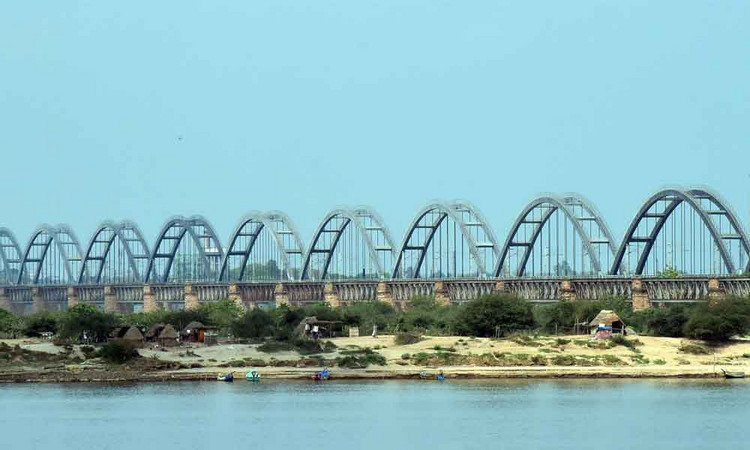
(Image Credit: The Hans India)
Frederick Thomas Granville Walton was the Chief Engineer overseeing the construction of Havelock Bridge. It has 56 spans of 45.7 meters each and measures 2,480 meters in length and is constructed of steel girders and stone masonry.
It is the oldest among the three Godavari Bridges and it was replaced by the Godavari Arch Bridge after being decommissioned in 1997.
However, the mighty Havelock Bridge is still widely renowned for its steely resilience. While it only had a life expectancy of 70 years by the end of its construction, it went on to last an astonishing 97 years. It is presently a national historic monument with plans of making it open for tourism.
Nehru Setu Bridge, Bihar
Boasting a length of 3,059 meters, the Nehru Setu Bridge is the second-longest railway bridge in India. It is also commonly known as the Upper Son Bridge. The bridge was inaugurated on February 27, 1900. It stretches across the Son River and connects Son Nagar and Dehri-on Son Bridge, running parallel to National Highway 2.
The Bridge has been constructed using steel girders that rest on 93 stone pillars and is 3,064 meters in length. It was the longest bridge in India at the time of its constriction and is considered to be the world’s second-longest bridge.
Mahanadi Rail Bridge, Odisha
The Mahanadi Rail Bridge stretches over the Mahanadi which is located in Cuttack in Odisha. There have been two Mahandi Bridges built since colonial times to the present day.
The first Mahanadi Rail Bridge was inaugurated on January 1, 1899. Each of its spans was 30 meters in length, and its wells were 5.94 meters in diameter and sunk to 80 meters below low water level.
William Becket was the engineer who was in charge of the construction of the bridge. He later went on to present a paper on the construction of the bridge two years later to the Institute of Civil Engineers. For this, he was presented with a gold medal by the Institute.
The Second Mahanadi Bridge was commissioned in 2008 and was built at a cost of INR 120 crore (US$ 15 Million). The bridge is capable of withstanding train speeds of up to 160 km per hour and also has adequate measures in place for withstanding earthquakes.
Balawali Railway Bridge, Uttar Pradesh
This bridge is also known as the Anderson Bridge over the Ganga in Balawali in 1888. It is named after Engineer Sir Jacob Anderson who was in charge of its construction. The original bridge was closed in the year 2000 and was subsequently replaced by a new bridge.
In 2016, the original bridge was re-opened, only this time, it was used for road traffic instead of trains. It is considered to be a very important landmark of the border between Uttar Pradesh and Uttarakhand.
The Old Anderson Bridge on the Ganga Main River with the first bridge being Malviya Bridge at Varanasi. It is also the first bridge on the Ganga River upstream.
Trains Passing Over Balawali Railway Bridge
- 14266 | Ddn Bsb Express - Dehradun (DDN) To Varanasi Jn (BSB)
- 14265| Bsb Ddn Express - Varanasi Junction (BSB) To Ramnagar (RMR)
- 54251| Lko Sre Passenger - Lucknow Nr (LKO) To Saharanpur (SRE)
Godavari Arch Bridge, Andhra Pradesh
This bowstring-arch bridge is located in Ramjahmudry in Andhra Pradesh, India. It is the newest among three bridges that extend across the Godavari River. It replaced the Havelock Bridge in 1997 after it was decommissioned.
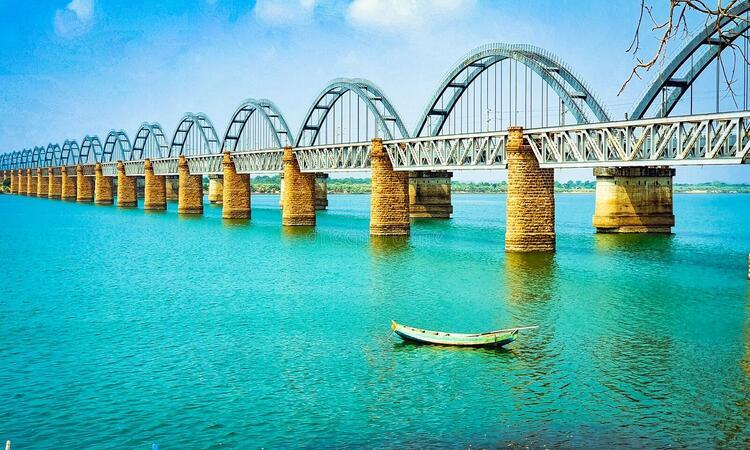
(Image Credit: Dreamstime)
The bridge has been constructed using a prestressed bowstring girder-type concrete arch with a prestressed concrete box girder acting as the tie. It has 28 twin arches of identical spans, designed to share 80% of dead load and live load.
Chenab Railway Bridge, Jammu & Kashmir
This arch bridge made of steel and concrete between Kauri and Bakkal has located just 42 km from Resai Town in Jammu and Kashmir. Standing at 359 m above the surface of the Chenab River, it is the world’s highest railway bridge. It is also one of the newest railway bridges in India, having been inaugurated in August 2022.
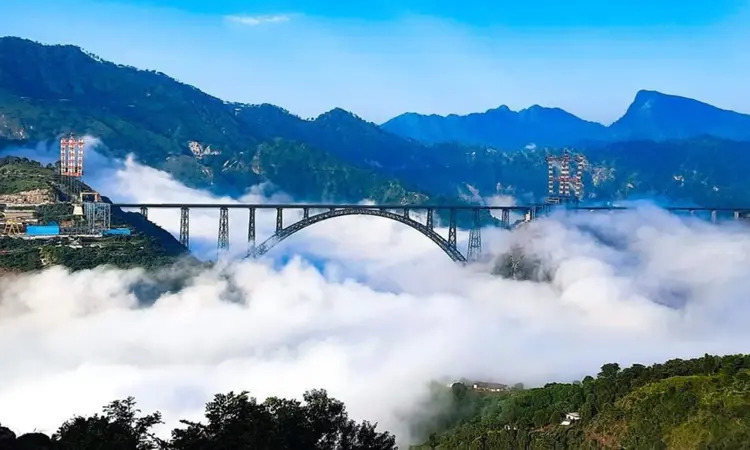
(Image Credit: Architectural Digest India)
The Chenab Bridge has been designed as a large-span single-arch steel bridge with approach Viaducts have been fitted on both sides. The two-ribbed arch of the bridge has been fabricated from large steel trusses.
The employment of continuous construction has allowed for the use of a minimal number of bearings, especially on the approach viaduct. This helps to reduce the inspection and maintenance efforts and allows for better riding quality.
Connecting Places Connecting People
There is an old saying that bridges are roads to success. In India, they can also be considered one of the hallmarks of success since they are an important factor in assessing the country’s infrastructure. Connecting people and places are the primary purpose of bridges.
All of the bridges mentioned here have proven to be very well-constructed with many of them having effectively stood the test of time. They have also been instrumental in facilitating effective transport around the country.

